An outdoor lighting installation
complies with the Energy Standards if the actual outdoor lighting power is no greater than the
allowed outdoor lighting power. This section describes the procedures and
methods for complying with §140.7.
The area of the lighting
application must be defined exclusive of any areas on the site that are not
illuminated.
The allowed lighting power is
determined by measuring the area or length of the lighting application and
multiplying this area (in W/ sq. ft.) or length (in W/sq. ft. by the Lighting
Power Allowance (in W) to arrive the allowed lighting power. The allowed
lighting power must be calculated for the general hardscape lighting of the site and
for specific applications if desired. (See §140.7(d))
The allowed outdoor lighting power
is calculated by lighting zone as defined in §10-114.
Local governments may amend lighting zones in compliance with §10-114.
See Section
6.4.1 for more information about amending outdoor ordinances by local
jurisdictions.
The actual power of outdoor
lighting is the total watts of all of the non-exempt lighting systems (including
ballast, driver or
transformer loss) (See §140.7(c)).
A. Maximum Outdoor Lighting
Power
The Energy Standards establish
maximum outdoor lighting power that can be installed. The allowed outdoor
lighting power must be determined according to the outdoor lighting zone in
which the site is located. See Section
6.4.1 for more information about outdoor lighting zones.
The wattage of outdoor luminaires
must be determined in accordance with §130.0(c)
or Reference Nonresidential Appendix NA8. See Section 5.3 for
more information about determining luminaire wattage.
The total allowed lighting power is
the combined total of all of the allowed lighting power layers. There are
lighting power allowances for general hardscape lighting and lighting power
allowances for specific applications. An outdoor lighting installation complies
with the lighting power requirements if the actual outdoor lighting power
installed is no greater than the allowed outdoor lighting power calculated under
§140.7(d)
and complies with certain stipulations associated with specific special
application allowances. The allowed lighting power shall be the combined total
of the sum of the general hardscape lighting allowance determined in accordance
with §140.7(d)1,
and the sum of the additional lighting power allowance for specific applications
determined in accordance with §140.7(d)2.
See Section
6.4.3 for a detailed explanation in determining the total allowed lighting
power.
B. Illuminated Area
With indoor lighting applications,
the entire floor area is considered to be illuminated for the purpose of
determining the allowed lighting power. However, for outdoor lighting
applications, the number of luminaires, mounting heights and layout affect the
presumed illuminated area and therefore the allowed lighting power.
The area of the lighting
application may not include any areas on the site that are not illuminated. The
area beyond the last luminaire is considered illuminated only if it is located
within 5 mounting heights of the nearest luminaire.
In plan view of the site, the
illuminated area is defined as any hardscape area within a square pattern around
each luminaire or pole that is 10 times the luminaire mounting height, with the
luminaire in the middle of the pattern. Another way to envision this is to
consider an illuminated area from a single luminaire as the area that is 5 times
the mounting height in four directions.
Illuminated areas shall not include
any area that is obstructed by any other structure, including a sign, within a building, or areas
beyond property lines.
The primary purpose for validating
the illuminated area is to exclude any areas that are not illuminated. Areas
that are illuminated by more than one luminaire shall not be double counted. An
area is either illuminated or it is not illuminated.
When luminaires are located further
apart (more than 10 times their mounting height apart), then the illuminated
area stops at 5 times the mounting height of each luminaire.
Planters and small landscape areas
are included within the general hardscape area as long as the short dimension of
the inclusion is less than 10 ft. wide, and the inclusion is bordered on at
least three sides.
Landscape areas that are greater
than 10 ft. wide in the short dimension are excluded from the general hardscape
area calculation, but the perimeter of these exclusions may be included in the
linear wattage allowance (LWA) calculation.
The allowed lighting power shall be the combined total of the
sum of the general hardscape lighting allowance determined in accordance with
§140.7(d)1,
and the sum of the additional lighting power allowance for specific applications
determined in accordance with §140.7(d)2.
A.
Calculation of Allowed Lighting Power - General Hardscape Lighting Allowance
Hardscape is defined in
§100.1 as an
improvement to a site that is paved and has other structural features, including
but not limited to, curbs, plazas, entries, parking lots, site roadways,
driveways, walkways, sidewalks, bikeways, water features and pools, storage or
service yards,
loading docks, amphitheaters, outdoor sales lots, and private monuments and
statuary.
General Hardscape lighting
allowance = (Hardscape Area x AWA) + (Perimeter Length of Hardscape Area x LWA)
+ IWA
Determine the general
hardscape lighting power allowances as follows:
1. The general
hardscape area of a site shall include parking lot(s), roadway(s),
driveway(s), sidewalk(s), walkway(s), bikeway(s), plaza(s), bridge(s),
tunnel(s), and other improved area(s) that are illuminated. In plan view of the
site, determine the illuminated hardscape area, which is defined as any
hardscape area that is within a square pattern around each luminaire or pole that is ten times
the luminaire mounting height with the luminaire in the middle of the pattern,
less any areas that are within a building, beyond the hardscape area, beyond property lines, or
obstructed by a structure. The illuminated hardscape area shall include portions
of planters and landscaped areas that are within the lighting application and
are less than or equal to 10 feet wide in the short dimensions and are enclosed
by hardscape or other improvement on at least three sides. Multiply the
illuminated hardscape area by the Area Wattage Allowance (AWA) from Table 6-4
(Table
140.7-A) for
the appropriate lighting zone.
2. Determine the
perimeter length of the general hardscape area. The total hardscape perimeter is
the length of the actual perimeter of the illuminated hardscape on the property.
It shall not include portions of hardscape that are not illuminated according to
§140.7(d)1A. Multiply the
hardscape perimeter by the Linear Wattage Allowance (LWA) for hardscape from
Table 6-4 (Table
140.7-A) for
the appropriate lighting zone. Generally, if there is an enclosed exclusion in
the area AWA calculation, the perimeter may be included in the LWA
calculation.
The perimeter length
for hardscape around landscaped areas and permanent planters shall be determined
as follows:
a.
Landscaped areas completely enclosed within the hardscape area, and with a width
or length a minimum of 10 feet wide, shall have the perimeter of the landscaped
areas or permanent planter added to the hardscape perimeter length.
b.
Landscaped areas completely enclosed within the hardscape area, and with a width
or length less than 10 feet wide, shall not be added to the hardscape perimeter
length.
c.
Landscaped edges that are not abutting the hardscape shall not be added to the
hardscape perimeter length.
3. Determine the
Initial Wattage Allowance (IWA). The IWA is allowed to be used one time per
site. The purpose is to provide additional watts for small sites, or for odd
hardscape geometries. Add the IWA for general hardscape lighting from Table 6-4
(Table
140.7-A) for
the appropriate lighting zone.
The general hardscape
lighting allowance shall be the sum of the allowed watts determined from (1),
(2) and (3) above.
(Refer to Figure 6-1
for a concept layout of the general hardscape lighting allowance for area, and
perimeter, as well as initial wattage allowance.)
Table 6-3: General Hardscape Lighting Power Allowance
|
Type of Power
Allowance |
Lighting Zone
03 |
Lighting Zone
13 |
Lighting Zone
23 |
Lighting Zone
33 |
Lighting Zone
43 |
|
|
Asphalt/Concrete |
Asphalt/Concrete |
Asphalt. |
Concrete2 |
Asphalt |
Concrete2 |
Asphalt/Concrete |
|
|
Area Wattage
Allowance (AWA) |
No
allowance1 |
0.018 W/sq.
ft. |
0.023 W/sq.
ft. |
0.025 W/sq.
ft. |
0.025 W/sq.
ft. |
0.03 W/sq.
ft. |
0.03 W/sq.
ft |
|
|
Linear
Wattage Allowance (LWA) |
0.15
W/lf |
0.17
W/lf |
0.4
W/lf |
0.25
W/lf |
0.4
W/lf |
0.35
W/lf |
|
|
Initial
Wattage Allowance (IWA) |
180
W |
250
W |
250
W |
350
W |
350
W |
400
W |
|
|
1 Continuous lighting is
explicitly prohibited in Lighting Zone 0. A single luminaire of 15 Watts or less
may be installed at an entrance to a parking area, trail head, fee payment
kiosk, outhouse, or toilet facility, as required to provide safe
navigation of the site infrastructure. Luminaires installed shall meet the
maximum zonal lumen limits as specified in 130.2(b).
2 Where greater than 50% of the
paved surface of parking lot is finished with concrete. This does not
extend beyond the parking lot, and does not include any other General Hardscape
area.
3 Narrow band spectrum
light sources
with a dominant peak wavelength greater than 580 nm – as mandated by
local, state, or federal agencies to minimize the impact, active
professional astronomy or nocturnal habitat of special local fauna,
shall be allowed a 2.0 lighting power allowance multiplier. |
Table
140.7-A from the Energy Standards
The allowed lighting power for
general hardscape lighting is calculated using the following components:
1. Area Wattage
Allowance (AWA), which is the area of the illuminated hardscape, and is
expressed in watts per sq. ft.
2. Linear
Wattage Allowance (LWA), which is the length of the perimeter of the illuminated
hardscape, and is expressed in watts per linear foot.
3. Initial
Wattage Allowance (IWA), which is a flat allowance for each property, and is
expressed in watts.
To determine the total
allowed power for general hardscape lighting, use the equation: (Hardscape area
x AWA) + (Hardscape perimeter x LWA) + (IWA).
Example 6-13 Outdoor
Lighting for Healthcare Facilities
Question
Is the
parking lot outside of a healthcare facility (“I” occupancy) regulated by the Energy
Standards?
Answer
Healthcare
facilities overseen by the California Office of Statewide Health Planning and
Development (OSHPD)
have to comply with California Energy Standards including the outdoor lighting
requirements for all outdoor areas of healthcare facilities. For outdoor lighting, a
licensed healthcare facility has to meet the outdoor lighting power requirements
as specified in Section 140.7, as
well as the outdoor lighting control requirements in Section 130.2.
Example 6-14
Hardscape Materials for Parking Lots
Question
Our overflow
parking lot is covered with gravel. Is this parking lot considered “hardscape,”
and must it comply with the Energy Standards?
Answer
Yes, parking
lots covered with gravel, or any other material used to enhance the surface to
accommodate parking or travel, such as pavers, asphalt, cement, or other
pervious or non-pervious materials are considered hardscape and must comply with
the requirements for hardscape areas.
Example
6-15 Power Allowance for a Parking Lot
Question
In a parking
lot in front of a
retail store, we are not using the full lighting power allowed according to Table
140.7-A. Can we use the remaining allowance to illuminate the building entrance
and the walkways near the store to a higher level?
Answer
Yes. Because
hardscape power densities are tradable, you may use the unused portion of the
power allowance in the parking lot to increase the illumination levels for other
lighting applications, including building entrance and walkway areas.
Example
6-16 Calculating the Illuminated Area of a Parking Lot
Question
A parking lot
is only illuminated from a series of 5 cut-off wall packs mounted on an adjacent
building. The parking lot extends 100 ft. from the building. The luminaires are
mounted at a height of 15 ft. above the ground and spaced 50 ft. apart. How
large is the illuminated area?
Answer
The
illuminated area extends a distance equal to 5 times the mounting height in
three directions (the fourth direction is not counted because it is covered by
the building). The illuminated area therefore extends from the building a
distance of 75 ft. The total illuminated area is 75 ft. x 350 ft. or 26,250 sq.
ft.
Example
6-17 Calculating the Illuminated Area
Question
1
If a pole has
a height of 15 ft., what are the dimensions of the square pattern used for power
calculations?
Answer
1
The
illuminated area is defined as any area within a square pattern around each
luminaire or pole that is 10 times the luminaire mounting height, with the
luminaire in the middle of the pattern. It does not include any area that is
within a building, under a canopy, beyond property lines, or obstructed by a sign or structure.
Therefore, for a 15 ft. pole, the area will be described by a square that is 150
ft. (15 ft. x 10) on each side, or 22,500 sq. ft. (150 ft. x 150 ft.), minus
areas that are beyond the property line or other obstructions.
Question
2
If two poles
in the center of an illuminated area are separated by a distance greater than 10
times the mounting height, will all of the square footage between them be
included in the area?
Answer
2
In most
applications, such as parking lots, these square patterns will typically
overlap, so the entire area of the parking lot between poles will typically be
included when determining the lighting power budget. However, if the poles are
so far apart that they exceed 10 times the mounting height of the luminaires on
the poles, and the coverage squares do not overlap, then the non-illuminated
areas between poles cannot be included in determining illuminated hardscape
area.
Example
6-18 Calculating the Power Allowance for a Parking Lot
Question
The parking
lot with concrete surface as illustrated below has two luminaires that are
mounted at a height of 25 ft. What is the illuminated hardscape area and what is
the allowed lighting? The lot is located in Lighting Zone 3.
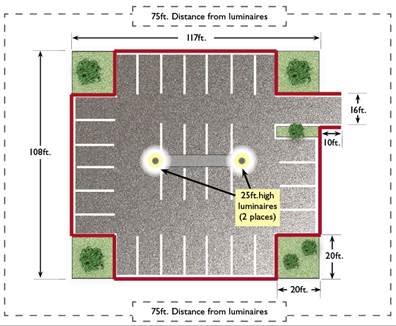
Answer
The poles are
40 ft. apart, and using the 10 times mounting height rule, the illuminated area
can be as large as 250 ft. by 290 ft. The boundary of this maximum illuminated
area extends beyond the edges of the parking lot as well as the entrance
driveway, so the entire paved area is considered illuminated. The landscaped island in
middle and peninsula below the entrance driveway are less than 10 ft. wide, so
they are included as part of the illuminated area, but not part of the hardscape
perimeter. The landscaped cutouts (20 x 20 ft.) in the corners of the parking
lot are bound by pavement on only two sides so they are not included. The total
paved area is 11,196 sq. ft.. [(12,636 sq. ft. + 160 sq. ft. (driveway) – 1,600
sq. ft (cutouts)]. The perimeter of the hardscape is 470 ft. [(2 x 77 ft.) + (2
x 68 ft.) + (8 x 20 ft.) + (2 X10 ft.)].





Three
allowances make up the total power allowance: Area, Linear, and Initial. All
allowances are based on a concrete surface of Lighting Zone 3 and found in Table
6-4 (Table
140.7-A of the Energy Standards).
The area
wattage allowance is equal to 335.9 W.
The linear
wattage allowance is equal to 188 W.
The initial
wattage allowance (IWA) is 350 W for the entire site.
The sum of
these three allowances gives a total wattage allowance for the site of 873.9
W.
The
calculation can also be tabulated as below.
|
Type
of Allowance |
Allowance |
Area/Perimeter Value |
Power Allowance |
|
Initial |
350 W |
- |
350 W |
|
Area |
0.03 W/sq. ft. |
11,196 sq. ft. |
336 W |
|
Perimeter |
0.4 W/LF |
470 ft. |
188 W |
|
TOTAL POWER ALLOWANCE |
874 W |
Example
6-19 Calculating the Illuminated Area of a Parking Lot
Question
In the
parking lot layout shown above, what would the illuminated area be and what
would the maximum allowed lighting power be if much smaller pedestrian style
poles were used at 8 ft. high and placed 30 ft. apart?
Answer
If the
mounting height is reduced to 8 ft., and the spacing to 30 ft. (and using the 10
times mounting height rule), the illuminated area can be a rectangle as large as
80 ft. by 110 ft. The hardscape area that intersects the maximum allowed
illuminated area is now 8,524 sq. ft. [(80 ft. x (80 ft. + 30 ft.) - 2 x (6 ft.
x 6 ft. cutouts) -2 x (6 ft. x 17 ft. cutouts)]. The new hardscape perimeter is
380 ft. [(2 x 88 ft.) + (2 x 68 ft.) + (4 x 6 ft.) + (2 x 6 ft.) + (2
x 16 ft.)].
Using the same
allowances as in the previous example, the total wattage allowance for the site
is 993.96 W (340.96 area W + 133 perimeter W + 520 initial W).
|
Type
of Allowance |
Allowance |
Area/Perimeter Value |
Power Allowance |
|
Initial |
520W |
- |
520 W |
|
Area |
0.040 W/ sq. ft. |
8524 sq. ft. |
341 W |
|
Perimeter |
0.35 W/LF |
380 ft. |
133 W |
|
|
TOTAL POWER ALLOWANCE |
994 W |
Example 6-20
Calculating the Power Allowance for a Roadway
Question
A 300 ft.
long, 15 ft. wide roadway leads through a wooded area to a hotel entrance in
Lighting Zone 2, and the owner wants to light the roadway with luminaires
mounted at a height of 20 ft. What is the allowed lighting power for this
roadway with asphalt surface?
Answer
The hardscape
area for the roadway must first be calculated. If the entire roadway will be
lit, then the 20 ft. poles will not be spaced more than 200 ft. apart and not
more than 100 ft. from the ends of the roadway. (Lighted area is 10 times the
pole height.) The hardscape area therefore is 15 ft. x 300 ft. or 4500 sq. ft.
The linear perimeter of this hardscape is the sum of the sides (not including
the side that connects to the larger site) 300 ft. + 15 ft. + 300 ft. or 615
ft.
Three
allowances make up the total power allowance: Area, Linear, and Initial.
However, the initial wattage allowance applies one time to the entire site. It
is not considered for usage for this roadway piece which would only be one small
part of the site. All allowances are based on an asphalt surface in Lighting
Zone 2 and can be found in Table 6-4 (Table
140.7-A of the Energy Standards).
The area
wattage allowance is equal to 103.5 W.
The linear
wattage allowance is equal to 104.6 W.
The sum of
these allowances gives a total wattage allowance for the roadway of 208.1 W.
The
calculation can also be tabulated as below
.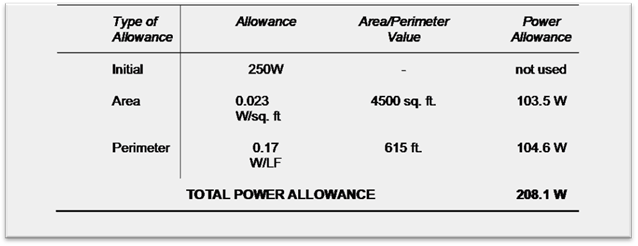

B. Calculation of Allowed Lighting Power -
Narrow Band Spectrum Light Source Applications
The 2019 Standards includes a
lighting power provision for narrow band spectrum light source application to
minimize the impact of electric light on local, active professional astronomy or
nocturnal habitat of specific local fauna. The provision is in the format of
lighting power multiplier as specified on the footnote of Table
140.7-A (footnote 3) which reads, “Footnote 3: Narrow band spectrum light
sources with a dominant peak wavelength greater than 580 nm – as mandated by
local, state, or federal agencies to minimize the impact on local, active
professional astronomy or nocturnal habitat of specific local fauna, shall be
allowed a 2.0 lighting power allowance multiplier.”
Example 6-21
Calculating the Illuminated Area of a Parking Lot
Question
The lighting
system for an
asphalt parking lot in Lighting Zone 2 is being designed next to an active,
professional astronomical observatory. The parking lot is 800 sq. ft. with a
perimeter of 280 linear feet. All lighting within 10 miles of the observatory is
required by a local ordinance to use a narrow band spectrum light source with a
wavelength above 580 nm to be compatible within the telescopes’ ability to
filter out stray light while capturing most of the wavelengths of light from the
night sky. Spectral power distributions of two amber light sources are shown in
the two images in Figure 6-21a.
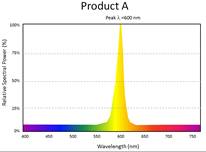
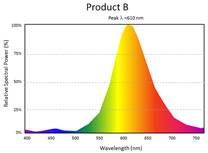
Figure 6-21a Spectral Distribution of Light Source Product A and
B
Question 1:
Which of these products meet criteria for “narrow band spectrum” light
sources?
Question 2:
What is the allowed lighting power for this parking lot with and without the use
of a narrow band spectrum light source?
Answer
Answer 1:
Narrow band spectrum light sources are those which have a spectral power
distribution closely distributed around the wavelength of peak spectral power.
There are no spectral power limitations on the wavelengths that are within 20 nm
of the peak wavelength. As the spectrum diverges from the peak wavelength, the
allowed relative spectral power declines rapidly.
Between 20 to
75nm from peak wavelength, the spectral power shall be no greater than 50% of
the peak spectral power.
Beyond 75 nm
the spectral power shall be no greater than 10% of the peak spectral power. This
distribution is reflected in the narrow ban spectrum criteria line centered
around the peak wavelength in Figure 6-21b. As shown in the figure, Product A is
a narrow band spectrum light source as it fits within the spectral power
criteria, whereas Product B does not comply as the spectral power exceeds the
narrow band criteria.
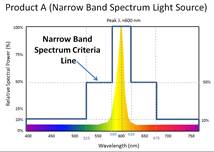
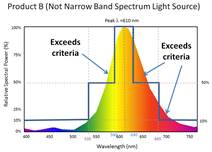
Figure 6-21b Spectral Distribution with Narrow Band Criteria
Superimposed
Answer 2: To
claim the two times multiplier for narrow band spectrum light sources, as
described in footnote 3 to Table
140.7-A, the project has to comply with all three of the following
criteria:
1. The light
source has to have a narrow band spectrum (true for product A).
2. The
dominant peak wavelength has to be greater than 580 nm (true for product A with
a peak wavelength of 600 nm).
3. The narrow band
spectrum and dominant peak wavelength of the light source has to be greater than
580 nm as mandated by local, state, federal agencies, to minimize the impact on
local, active professional
astronomy or on
the nocturnal habitat of specific local fauna. (The credit is not available
unless the ordinance specifically calls out a requirement for a narrow band
spectrum.)
The allowed
wattage without the narrow spectrum multiplier calculated as follows:
Allowed
Wattage = (Area Wattage Allowance) x (Area, sq. ft.) + (Linear Wattage
Allowance) x (Perimeter Length, linear ft.) + (Initial Wattage Allowance)
The asphalt
parking lot is 800 sf with a perimeter of 280 linear feet and is in Lighting
Zone 2. From Table
140.7-A in the asphalt column of Lighting Zone 2, the power allowance
factors are:
Area Wattage
Allowance = 0.023 W/sq. ft., Linear Wattage Allowance = 0.17 W/lf, and Initial
Wattage Allowance = 250 Watts.
Allowed
Wattage = (0.023 W/sq. ft) x (800 sq. ft.) + (0.17 W/lf) x (280 lf) + (250 W) =
316 Watts
If the design
makes use of narrow band light sources and meets all three criteria of footnote
3 to Table
140.7-A, the allowed wattage is allowed a 2.0 lighting power allowance
multiplier.
Narrow Band
Allowed Wattage = Allowed Wattage x 2 = 316 Watts x 2 = 632 Watts.
Example
6-22 Low Blue Content Light Source Design
Question
A lighting
system is being designed for a similar parking lot as in Example 6-21 except
that it is next to a wildlife refuge and all outdoor lighting near the refuge is
required by a local ordinance to use low blue content light sources to minimize
the lighting impact on nocturnal animals.
If the
designer specifies a narrow band spectrum light source (such as Product A in
Example 6-21), can the designer make use of the narrow band spectrum lighting
power allowance multiplier in determining the lighting power allowance?
Answer:
To claim the
two-times multiplier for narrow band spectrum light sources, as described in
footnote 3 to Table
140.7-A, the project must comply with all three of the following
criteria:
1. The light
source has to have a narrow band spectrum.
2. The
dominant peak wavelength has to be greater than 580 nm.
3. The narrow
band spectrum and dominant peak wavelength of the light source be greater than
580 nm, as mandated by local, state, federal agencies to minimize the impact on
local, active professional astronomy or on the nocturnal habitat of specific
local fauna (The credit is not available unless the ordinance specifically calls
out a requirement for a narrow band spectrum.)
For this
example, the narrow band spectrum credit is not available since the local
ordinance called for low blue light content without specifying this had to be
accomplished with narrow band spectrum light sources with a dominant peak
wavelength greater than 580 nm. As a result, the two-times multiplier for narrow
band spectrum light sources cannot be used in calculating the lighting power
allowance for this project.
The lighting power for Specific
Applications provides additional lighting power that can be layered in addition to the
General Hardscape lighting power allowances as applicable.
Most of a site will be classified
as ‘General Hardscape’ and will be calculated using Table 6-4 (Table
140.7-A of the Energy Standards) as the only source of allowance.
Some portions of the site may fit
use categories that permit the inclusion of an additional lighting allowance for
that portion of the site. These Specific Applications are detailed in Table 6-5
(Table
140.7-B of the Energy Standards). Not all of these allowances are based on
area.
The single exception to this is the
allowance for Hardscape Ornamental Lighting, which is calculated independent of the
rest of the Specific Applications, and no regard to the overlap of this
Application is made. See Section E for more information about the Hardscape
Ornamental Lighting allowance.
Table 6-4: Additional Lighting Power Allowance for Specific
Applications
|
Lighting Application |
Lighting Zone 0 |
Lighting Zone 1 |
Lighting Zone 2 |
Lighting Zone 3 |
Lighting Zone 4 |
|
|
WATTAGE ALLOWANCE PER APPLICATION. Use all
that apply as appropriate. |
|
Building Entrances or Exits.
Allowance per door. Luminaires must be within 20 feet of the
door. |
Not applicable |
15
watts |
25
watts |
35
watts |
45
watts |
|
Primary Entrances to
Senior Care Facilities, Police Stations, Healthcare
Facilities, Fire Stations, and Emergency Vehicle Facilities.
Allowance per primary entrance(s) only. Primary entrances are entrances
that provide access for the general public. This allowance is in addition to
the building entrance or exit allowance above. Luminaires must be within
100 feet of the primary entrance. |
Not applicable |
20
watts |
40
watts |
57
watts |
60
watts |
|
Drive Up Windows.
Allowance per customer service location. Luminaires must be within 2 mounting
heights of the sill of the window. |
Not applicable |
16
watts |
30
watts |
50
watts |
75
watts |
|
Vehicle Service Station Uncovered Fuel
Dispenser. Allowance per fueling dispenser. Luminaires must be
within 2 mounting heights of the dispenser. |
Not applicable |
55
watts |
77
watts |
81
watts |
135
watts |
|
ATM Machine Lighting.
Allowance per ATM machine. Luminaires must be within 50 feet of the
dispenser. |
Not applicable |
100 watts for first ATM machine, 35 watts
for each additional ATM machine. |
|
|
WATTAGE ALLOWANCE PER UNIT LENGTH (w/linear ft.).
May be used for one or two frontage side(s) per site. |
|
Outdoor Sales Frontage.
Allowance for frontage immediately adjacent to the principal viewing
location(s) and unobstructed for its viewing length. A corner sales
lot may include two adjacent sides provided that a different principal
viewing location exists for each side. Luminaires must be located between
the principal viewing location and the frontage outdoor sales area. |
Not applicable |
No Allowance |
11
W/linear ft. |
19
W/linear ft. |
25
W/linear ft. |
|
|
WATTAGE ALLOWANCE PER HARDSCAPE AREA (W/sq. ft.).
May be used for any illuminated hardscape area on the site. |
|
Hardscape Ornamental Lighting. Allowance for the total site
illuminated hardscape area. Luminaires must be rated for 100 watts or less
and be post-top luminaires, lanterns, pendant luminaires, or
chandeliers. |
Not applicable |
No Allowance |
0.007
W/sq. ft. |
0.013
W/sq. ft. |
0.019
W/sq. ft. |
|
|
WATTAGE ALLOWANCE PER SPECIFIC AREA (W/sq. ft.).
May be used as appropriate provided that only one is used for a given area
(i.e., provided that two allowances are not applied to the same
area). |
|
Building Facades.
Only areas of building façade that are illuminated qualify for this
allowance. Luminaires must be aimed at the façade and capable of
illuminating it without obstruction or interference by permanent building
features or other objects. |
Not applicable |
No Allowance |
0.100
W/sq. ft. |
0.170
W/sq. ft. |
0.225
W/sq. ft. |
|
Outdoor Sales
Lots. Allowance for uncovered sales lots used exclusively for the
display of vehicles or other merchandise for sale. Driveways, parking lots
or other non-sales areas are considered hardscape areas even if these
areas are completely surrounded by sales lots on all sides. Luminaires
must be within 5 mounting heights of the sales lot area. |
Not applicable |
0.060
W/sq. ft. |
0.210
W/sq. ft. |
0.280
W/sq. ft. |
0.485
W/sq. ft. |
|
Vehicle Service Station
Hardscape. Allowance for the total illuminated hardscape area less
area of buildings, under canopies, off property, or obstructed by signs or
structures. Luminaires must be illuminating the hardscape area and must
not be within a building, below a canopy, beyond property lines, or
obstructed by a sign or other structure. |
Not applicable |
0.006
W/sq. ft. |
0.068
W/sq. ft. |
0.138
W/sq. ft. |
0.200
W/sq. ft. |
|
Vehicle Service Station
Canopies. Allowance for the total area within the drip line of the
canopy. Luminaires qualifying for this allowance shall be located under
the canopy. |
Not applicable |
0.220
W/sq. ft. |
0.430
W/sq. ft. |
0.580
W/sq. ft. |
1.010
W/sq. ft. |
|
Sales Canopies.
Allowance for the total area within the drip line of the canopy.
Luminaires must be located under the canopy. |
Not applicable |
No Allowance |
0.470
W/sq. ft. |
0.622
W/sq. ft. |
0.740
W/sq. ft. |
|
Non-sales Canopies and
Tunnels. Allowance for the total area within the drip line of the
canopy or inside the tunnel. Luminaires must be located under the canopy
or tunnel. |
Not applicable |
0.057
W/sq. ft. |
0.137
W/sq. ft. |
0.270
W/sq. ft. |
0.370
W/sq. ft. |
|
Guard Stations.
Allowed up to 1,000 square feet per vehicle lane. Guard stations provide
access to secure areas controlled by security personnel who stop and may
inspect vehicles and vehicle occupants, including identification,
documentations, vehicle license plates, and vehicle contents. Qualifying
luminaires shall be within 2 mounting height of a vehicle lane or the
guardhouse. |
Not applicable |
0.081
W/sq. ft. |
0.176
W/sq. ft. |
0.325
W/sq. ft. |
0.425
W/sq. ft. |
|
Student Pick-up/Drop-off
zone. Allowance for the area of the student pick-up/drop-off, with
or without canopy, for preschool through 12th grade school
campuses. A student pick-up/drop off zone is a curbside, controlled
traffic area on a school campus where students are picked-up and dropped
off from vehicles. The allowed area shall be the smaller of the actual
width or 25 feet, times the smaller of the actual length or 250 feet.
Qualifying luminaires shall be within 2 mounting heights of the student
pick-up/drop-off zone. |
Not applicable |
No Allowance |
0.056
W/sq. ft. |
0.200
W/sq. ft. |
No Allowance |
|
Outdoor Dining.
Allowance for the total illuminated hardscape of outdoor dining. Outdoor
dining
areas are hardscape areas used to serve and consume food and
beverages. Qualifying luminaires shall be within 2 mounting heights of the
hardscape area of outdoor dining. |
Not applicable |
0.004
W/sq. ft. |
0.030
W/sq. ft. |
0.050
W/sq. ft. |
0.075
W/sq. ft. |
|
Special Security Lighting
for Retail Parking and Pedestrian Hardscape. This additional
allowance is for illuminated retail parking and pedestrian hardscape
identified as having special security needs. This allowance shall be in
addition to the building entrance or exit allowance. |
Not applicable |
0.004
W/sq. ft. |
0.005
W/sq. ft. |
0.010
W/sq. ft. |
No Allowance |
Table
140.7-B from the Energy Standards
Assigned lighting applications must be
consistent with the actual use of the area. Outdoor lighting definitions
in §100.1 must be used
to determine appropriate lighting applications.
Specific Applications that are
based on specific instances on the site are the cumulative total of those
instances on the site, with the allowance being accumulated per instance.
Specific Applications that are
based on the length of an instance on the site are calculated by multiplying the
total length of the instance by the allowance per linear foot for the
Application.
A.
General Hardscape Power Trade-Offs
Allowed lighting power determined
according to §140.7(d)1
for general hardscape lighting may be traded to specific applications in §140.7(d)2,
as long as the hardscape area from which the lighting power is traded continues
to be illuminated in accordance with §140.7(d)1A.
B.
Specific Allowances Power Trade-Offs Not Allowed
Allowed lighting power for specific
applications shall not be traded between specific applications, or to hardscape
lighting in §140.7(d)1.
This means that for each and every specific application, the allowed lighting
power is the smaller of the allowed power determined for that specific
application according to Table
140.7-B, or the actual installed lighting power that is used in that
specific application.
C.
Wattage Allowance per Application
The applications in this category
are provided with additional lighting power, in watts (W) per instance, as
defined in Table 6-5 (Table
140.7-B of the Energy Standards). Use all that apply as appropriate. Wattage
allowances per application are available for the following areas:
•
Building entrances or exits.
•
Primary entrances of senior care facilities, police stations, healthcare
facilities, fire stations, and emergency vehicle facilities.
•
Drive-up windows. See Section 6.4.5F for additional information about
drive-up windows
•
Vehicle service station uncovered fuel dispenser. See Section 6.4.5C for
additional information about vehicle service stations.
• ATM
machine lighting
D.
Wattage Allowance for Outdoor Sales Frontage Application
The wattage allowance per linear
foot is available only for outdoor sales frontage immediately adjacent to the
principal viewing location(s) and unobstructed for its viewing length. A corner
sales lot may include two adjacent sides provided that a different principal
viewing location exists for each side. Luminaires qualifying for this allowance
shall be located between the principal viewing location and the frontage
outdoor. The outdoor sales frontage allowance is calculated by multiplying the
total length of qualifying sales frontage by the outdoor sales frontage lighting
allowance in Table 6-5 (Table
140.7-B of the Energy Standards). See Section 6.4.5B for additional
information about sales frontage.
E.
Wattage Allowance per Hardscape Ornamental Lighting
Application
The ornamental lighting allowance
on the site is calculated by multiplying the total illuminated hardscape for the
site by the hardscape ornamental lighting allowance in Table 6-5 (Table
140.7-B of the Energy Standards), in watts per square foot
(W/ft2). Luminaires qualifying for this allowance shall be rated for
100 W or less as determined in accordance with §130.0(c),
and shall be post-top luminaires, lanterns, pendant luminaires, or chandeliers.
This additional wattage allowance may be used for any illuminated hardscape area
on the site. See Section 6.4.5E, Ornamental Lighting, for
additional information about ornamental lighting.
F.
Wattage Allowance per Specific Area
Applications in this category are
provided with additional lighting power, in watts per square foot (W/ sq. ft. ),
as defined in Table
140.7-B of the Energy Standards (Table 6-5). Wattage allowances per specific
area are available for the following areas:
1.
Building Facades
Only areas of building façade that
are illuminated shall qualify for this allowance. Luminaires qualifying for this
allowance shall be aimed at the façade and shall be capable of illuminating it
without obstruction or interference by permanent building features or other
objects. See Section 6.4.5A for additional information about building
facades.
2.
Outdoor Sales Lots
Allowance for uncovered sales lots
used exclusively for the display of vehicles or other merchandise for sale.
Driveways, parking lots or other non-sales areas shall be considered hardscape
areas, not outdoor sales lots, even if these areas are completely surrounded by
sales lot on all sides. Luminaires qualifying for this allowance shall be within
5 mounting heights of the sales lot area. See 6.4.5B for more information.
3.
Vehicle Service Station Hardscape
Allowance for the total illuminated
hardscape area less area of buildings, under canopies, off property, or
obstructed by signs or structures. Luminaires qualifying for this allowance
shall be illuminating the hardscape area and shall not be within a building,
below a canopy, beyond property lines, or obstructed by a sign or other
structure.
4.
Vehicle Service Station Canopies
Allowance for the total area within
the drip line of the canopy. Luminaires qualifying for this allowance shall be
located under the canopy. See Section 6.4.5C for additional information about
vehicle service stations.
5.
Sales Canopies
Allowance for the total area within
the drip line of the canopy. Luminaires qualifying for this allowance shall be
located under the canopy. See Section 6.4.5D for additional information about
lighting under canopies.
6.
Non-sales Canopies and Tunnels
Allowance for the total area within
the drip line of the canopy or inside the tunnel. Luminaires qualifying for this
allowance shall be located under the canopy or tunnel. See Section 6.4.5D for
additional information about lighting under canopies.
7.
Guard Stations
Allowance up to 1,000 sq. ft. per
vehicle lane. Guard stations provide access to secure areas controlled by
security personnel who stop and may inspect vehicles and vehicle occupants,
including identification, documentation, vehicle license plates, and vehicle
contents. Qualifying luminaires shall be within 2 mounting heights of a vehicle
lane or the guardhouse. See Section 6.4.5G for additional information about
guarded facilities.
8.
Student Pick-up/Drop-off zone
Allowance for the area of the
student pickup/drop-off zone, with or without canopy, for preschool through 12th
grade school campuses. A student pick-up/drop off zone is a curbside, controlled
traffic area on a school campus where students are picked up and dropped off
from vehicles. The allowed area shall be the smaller of the actual width or 25
ft., multiplied by the smaller of the actual length or 250 ft. Qualifying
luminaires shall be within 2 mounting heights of the student pick-up/drop-off
zone.
9.
Outdoor Dining
Allowance for the total illuminated
hardscape of outdoor dining. Outdoor dining areas are hardscape areas used to
serve and consume food and beverages. Qualifying luminaires shall be within 2
mounting heights of the hardscape area of outdoor dining.
10.
Special Security Lighting for Retail Parking and Pedestrian Hardscape
This additional allowance is for
illuminated retail parking and pedestrian hardscape identified as having special
security needs. This allowance shall be in addition to the building entrance or
exit allowance.
A. Building Facades
Building façade is defined in
§100.1 as the
exterior surfaces of a building, not including horizontal roofing, signs, and surfaces
not visible from any public viewing location. Only areas of building façade that are
illuminated should qualify for this allowance. Luminaires qualifying for this
allowance should be aimed at the façade and should be capable of illuminating it
without obstruction or interference by permanent building features or other
objects.
Building façades and architectural
features may be illuminated by flood lights, sconces or other lighting attached to
the building. Building façade lighting is not permitted in Lighting Zone 0 and
Lighting Zone 1. Façade orientations that are not illuminated and façade areas
that are not illuminated because the lighting is obstructed shall not be
included. General site illumination, sign lighting, and/or lighting for other specific applications
can be attached to the side of a building and not be considered façade lighting.
Wall packs mounted on sides of the buildings are not considered façade lighting
when most of the light exiting these luminaires lands on areas other than the
building façade.
Example 6-23
Calculating the Allowance for a Projected Area
Question
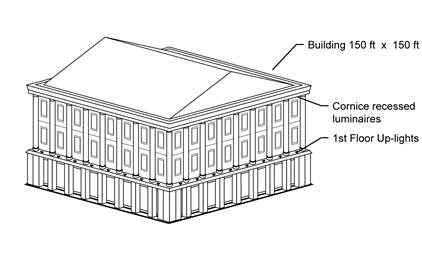
(Lighting
Zone 3) A city wants to illuminate its city hall on two sides (two facades). The
structure is a three-story building with a colonnade on the second and third
floors and a cornice above. The columns are considered important architectural
features and the principal goal of the lighting project is to highlight these
features. The columns are 30 ft. tall x 3 ft. in diameter and are spaced at 8
ft. For the purposes of determining the lighting power allowance for the
building, what is the surface area to be illuminated? What is the lighting power
allowance? The columns will be illuminated by downlights at the cornice and
uplights above the first floor.
Answer
The area of
the façade for the purposes of calculating the lighting allowance is the
projected area of the illuminated façade. Architectural features such as
columns, recesses, facets, etc. are ignored. The illuminated area for each
façade is therefore 30 ft. x 150 ft. or 4,500 sq. ft. The façade allowance for
Lighting Zone 3 is 0.17 W/sq. ft., so the total power allowed is 765 W per
façade, or 1,530 W total.
|
Type
of Allowance |
Allowance |
Area/Perimeter Value |
Power Allowance |
|
Facade
|
0.17 W/ sq. ft. |
A. 4,500 sq. ft.
|
765 W per facade |
|
TOTAL POWER ALLOWANCE |
1,530 W |
Example 6-24
Permanent vs. Temporary Façade Lighting
Question
I am
designing a high-rise building and permanently mounted marquee lights will be
installed along the corners of the building. The lights will be turned on at
night, but only for the holiday season, roughly between mid-November and
mid-January. The lights consist of a series of 7 W LED luminaires spaced at 12
inches on-center (OC) along all the corners of the building and along the top of
the building. Essentially, the lights provide an outline of the building. For
the purposes of the Outdoor Lighting Standards, are these considered façade lighting? Because they
will only be used for about two months of the year, are they considered temporary
lighting and exempt?

Answer
The lighting
is permanent lighting and must comply with the Energy Standards. Temporary
lighting is defined in §100.1 as is a
lighting installation with plug-in connections that does not persist beyond 60
consecutive days or more than 120 days per year. Anything that is permanently
mounted to the building is considered permanent lighting, and the hours of
intended use do not affect its status as permanent lighting.
Because this
lighting is primarily used to accent the architectural outline of the building,
it may be considered façade lighting. And because all corners of the building
are illuminated, all four facades may be considered to be illuminated. The area
on each façade is 80 ft. x 100 ft. or 8,000 sq. ft.. The total illuminated area
is four times 8,000 sq. ft. or 32,000 sq. ft.. The Lighting Zone 3 allowance for
façade lighting is 0.17 W/sq. ft. and the total power allowance for façade
lighting is 5,440 W.
There are 100
ft. x 4 plus 80 ft. x 4 lamps (a total of 720 luminaires) on the building. Each
luminaire is 7
W. The installed power is 720 luminaires times 7 W/luminaire or 5,040 W. The
installed power is less than the allowance so the façade lighting complies. If
this building were in Lighting Zone 2, the allowance would be 0.1 W/sq. ft. or a
total of 3,200 W. The lighting design would not comply in Lighting Zone 2.
|
Type
of Allowance |
Allowance |
Area/Perimeter Value |
Power Allowance |
|
Facade |
0.17 W/ sq. ft. |
32,000 sq. ft. |
5,440 W |
|
TOTAL POWER ALLOWANCE |
5,440 W |
Example 6-25
Power Allowance for Facades
Question
Portions of
the front façade of
a proposed wholesale store in Lighting Zone 3 are going to be illuminated. The
front wall dimensions are 120 ft. by 20 ft. There is 250 ft.² of fenestration in
the front wall that is illuminated by the façade lighting. Signs cover another
500 ft.² of the front wall, and another 400 sq. ft. is not illuminated at all.
What is the allowed front façade lighting power?
Answer
The gross
wall area is 2,400 sq. ft. (120 x 20). However, we must subtract all those
areas that are not illuminated. Note that because the 250 sq. ft. of
fenestration is intended to be illuminated by the façade lighting, this area may
be included in the total area eligible for power calculations.
The areas not
eligible for power calculations include:
500 sq. ft.
of signs + 400 sq. ft. of unlighted façade = 900 sq. ft.
Net wall area
used for façade lighting: 2,400 sq. ft. – 900 sq. ft. = 1,500 sq.
ft.
From Table
6-5 (Table 1407-B of the Energy Standards), the allowed façade lighting power density in Lighting
Zone 3 is 0.17 W/ sq. ft.
The
calculated allowed power based on net wall area is 1,500 sq. ft. x 0.17 W/ sq.
ft. = 255 W.
The allowed
power is therefore the smaller of actual wattage used for façade lighting or 255
W.
|
Type
of Allowance |
Allowance |
Area/Perimeter Value |
Power Allowance |
|
Facade |
0.17 W/ sq. ft. |
1,500 sq. ft. |
255 W |
|
TOTAL POWER ALLOWANCE |
255 W |
Example 6-26
Sign Lighting
Question
Is sign
lighting part of my façade lighting?
Answer
The sign area
must be subtracted from the façade area so that the area is not double counted.
The sign lighting must meet the requirements of the Energy Standards for sign
lighting. See Chapter 7 for
more information about sign lighting.
Example 6-27
Oranamental vs. Façade Lighting
Question
Is the
lighting of my parapet wall with small wattage decorative lighting considered
ornamental or façade lighting?
Answer
In this
example, the lamps attached to the building façade are considered façade
lighting. This cannot be considered ornamental lighting because
ornamental lighting is defined in Table
140.7-B of the Energy Standards as post-top luminaires, lanterns, pendant
luminaires, chandeliers.
Example 6-28
Hardscape vs.
Façade Lighting
Question
If I mount a
luminaire on the side of my building to illuminate an area is it considered
façade lighting or hardscape lighting?
Answer
It depends on
the primary intent of the luminaire. For example, if the luminaire is primarily
illuminating the walls (such as a sconce), then it should be considered part of the building
façade lighting. If on the other hand, the luminaire is primarily illuminating
the parking lot
beyond (most wall packs), then it should be part of the hardscape lighting. It
should be noted that lighting power tradeoffs are not allowed between building
façade and hardscape areas.
B.
Sales Frontage
This additional allowance is
intended to accommodate the retailers need to highlight merchandise to motorists
who drive by their lot. Outdoor sales frontage
includes car lots, but can also include any sales activity.
Outdoor sales frontage must be
immediately adjacent to the principal viewing
location(s) and unobstructed for its viewing length. A corner sales lot may
include two adjacent sides provided that a different principal viewing location
exists for each side. Luminaires qualifying for this allowance shall be located
between the principal viewing location and the frontage outdoor. The outdoor
sales frontage allowance is calculated by multiplying the total length of
qualifying sales frontage by the outdoor sales frontage lighting allowance in
Table 147-B of the Energy Standards.
When a sales lot qualifies for the
sales frontage allowance, the total sales lot wattage allowance is determined by
adding the following three layers:
•
General hardscape lighting power allowance
•
Outdoor sales frontage
• Outdoor sales
lot
C.
Vehicle Service Stations
According to the definition in §100.1, vehicle
service station is a gasoline, natural gas, diesel, or other fuel dispensing
station. In addition to allowances for building entrances and exits,
hardscape ornamental lighting, building façade, and outdoor dining allowances,
as appropriate; the total wattage allowance specifically applying to vehicle service station
hardscape is determined by adding the following layers, as appropriate:
•
General hardscape lighting power allowance
•
Vehicle service station uncovered fuel dispenser (allowance per fueling
dispenser, with 2 mounting heights of dispenser)
•
Vehicle service station hardscape (less area of buildings, under
canopies, off property, or obstructed by signs or other structures)
•
Vehicle service station canopies (within the drip line of the canopy)
The lighting power allowances are
listed in Table
140.7-B of the Energy Standards.
Figure 6-3: Service
Station Hardscape Areas
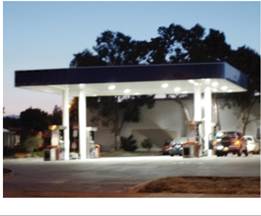
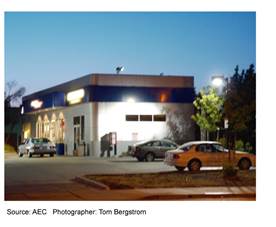
Example 6-29
Calculating Canopy Lighting Area and Hardscape Area
Question
Where does
canopy lighting area end and hardscape area start?
Answer
The horizontal
projected area of the canopy on the ground establishes the area for under canopy
lighting power calculations. This area also referred to as the “drip line” of
the canopy.
D.
Under Canopies
According to the definition in §100.1, a canopy is a permanent
structure, other than a parking garage, consisting of a roof and supporting building elements,
with the area beneath at least partially open to the elements. A canopy may be
freestanding or attached to surrounding structures. A canopy roof may serve as
the floor of a structure above.
The definition of a canopy states
that a canopy is not a parking garage. A parking garage is classified as an
unconditioned interior space, whereas a canopy is classified as an outdoor
space.
The lighting power allowance for a
canopy depends on its purpose. Service station canopies are treated separately
(see the previous section). The two types of canopies addressed in this section
are those that are used for sales and those that are not. Non-sales canopies
include covered walkways, and covered entrances to hotels, office buildings,
convention centers and other buildings. Sales canopies specifically cover and
protect an outdoor sales area, including garden centers, covered automobile
sales lots, and outdoor markets with permanent roofs. The lighting power
allowances are listed in Table
140.7-B of the Energy Standards.
The area of a canopy is defined as
the horizontal projected area, in plan view, directly underneath the canopy.
This area is also referred to as the “drip line” of the canopy. Canopy lighting,
either sales or non-sales shall comply separately, e.g. trade-offs are not
permitted between other specific lighting applications or with general site
illumination.
General site lighting or other
specific applications lighting, and/or sign lighting that are attached to the
sides or top of a canopy, cannot be considered canopy lighting. For example,
internally illuminated translucent panels on the perimeter of a canopy are
considered sign lighting, while the lighting underneath the canopy and directed
towards the ground is canopy lighting.
Figure 6-4: Canopy Lighting
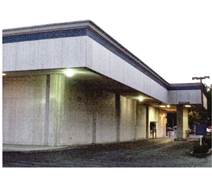
Source: AEC Photographer: Tom
Bergstrom
Example 6-30
Power Allowance Under Canopies
Question
The first
floor of an office tower in Lighting Zone 3 is setback 20 ft. on the street
side. The width of the recessed façade is 150 ft. The primary purpose of the
setback (and canopy) is to provide a suitable entrance to the office tower;
however, space under the canopy is leased as news-stand, a flower cart and a
shoe shine stand. These commercial activities occupy about half of the space
beneath the canopy. What is the allowed lighting power?
Answer
The total
canopy area is 20 ft. x 150 ft. or 3,000 sq. ft. The General Hardscape allowance
for the site will need to be separately determined. The canopy allowance is an
additional layer allowed only for the canopy area. The 1,500 ft.² used for the
flower cart, news-stand and shoe shine stand is considered a sales canopy and
the allowance is 0.622 W/ sq. ft. or a total of 933 W. The other 1,500 sq.
ft. is a non-sales canopy and the allowance is 0.270 W/ft.² or a total of
405 W. Trade-offs are not permitted between the sales portion and the non-sales
portions.
|
Type
of Allowance |
Allowance |
Area/Perimeter Value |
Power Allowance |
|
Non-Sales
Canopy |
0. 270W/ sq. ft. |
1,500 sq. ft. |
405 W |
|
Sales
Canopy |
0.622 w/ sq. ft. |
1,500 sq. ft. |
933 W |
|
TOTAL POWER ALLOWANCE |
1,338 W |
E.
Ornamental Lighting
Ornamental lighting is defined in
§100.1 as post-top
luminaires, lanterns, pendant luminaires, chandeliers, and marquee lighting. However,
marquee lighting does not qualify for the ornamental lighting allowance. The
allowances for ornamental lighting are listed in Table
140.7-B of the Energy Standards.
The ornamental lighting allowance
on the site is calculated by multiplying the total illuminated hardscape for the
site by the hardscape ornamental lighting allowance in Table
140.7-B. This allowance is calculated separately, and is not accumulated
into the other allowances. This additional wattage allowance may be used for any
illuminated hardscape area on the site.
Luminaires used for ornamental
lighting as defined in Table
140.7-B shall have a rated wattage, as listed on a permanent, pre-printed,
factory-installed
label, of 100 W or less.
Figure 6-6:
Ornamental Lighting
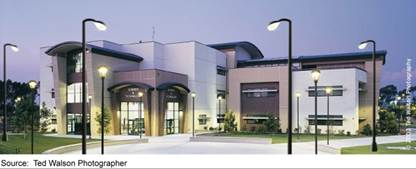
(The cobra head luminaires shown in the above figure are not
ornamental lighting. However, if the post-top acorn luminaires are rated 30
watts or less and not providing general and task lighting, they qualify as
ornamental lighting)
Example 6-31
Bollard Luminaires
Question
Are bollard
luminaires considered ornamental lighting?
Answer
No, Ornamental
lighting is defined in Table
140.7-B of the Energy Standards as post-top luminaires, lanterns, pendant
luminaires, chandeliers.
F.
Drive-up Windows
Drive-up windows are common for
fast food restaurants, banks, and parking lot entrances. In order to qualify, a
drive-up window
must have someone working behind the “window”. Automatic ticket dispensers at
parking lots do not count.
The lighting power allowances are
listed in Table
140.7-B of the Energy Standards as a wattage allowance per application.
The wattage allowance in Lighting
Zone 3 is 125 W for each drive-up window.
Luminaires qualifying for this
allowance must be within 2 mounting heights of the sill of the window.
Figure 6-6:
Drive-up Windows

Example 6-32
Power Allowance for Drive-up Window
Question
A drive-up
window in Lighting Zone 2 has width of 7 ft. What is the allowed lighting power
for this drive-up window?
Answer
The width of a
drive-up window in not used for determining the allowed wattage. In Lighting
Zone 2, 30 W is allowed for each drive-up window.
G.
Guarded Facilities
Guarded facilities, including gated
communities, include the entrance driveway, gatehouse, and guardhouse interior
areas that provide access to secure areas controlled by security personnel who
stop and may inspect vehicles and vehicle occupants including, identification
documentation, vehicle license plates, and vehicle contents.
There is an allowance of up to
1,000 sq. ft. per vehicle lane. Qualifying luminaires shall be within 2 mounting
heights of a vehicle lane or the guardhouse.
The power allowances for guarded
facilities are listed in Table
140.7-B of the Energy Standards.
Example
6-33 Power Allowance for Guard Stations
Question
A
guard station to the research campus of a defense contractor consists of a guard
station building of 300 ft.². Vehicles enter to the right of the station and
exit to the left. What is the outdoor lighting power allowance? The guard
station is located in Lighting Zone 2.
Answer
Since
there are two vehicle lanes, the allowance for Lighting Zone 2 is two times of
300 ft.² times 0.176 W/ft.² is 105.6 W, in addition to the general hardscape
lighting power allowance.
Example
6-34 Residential Guarded Facilities
Question
Is
the guarded facility at the entrance to a residential gated community covered by
the Energy Standards?
Answer
Yes,
residential guarded facilities are covered by the Energy
Standards.
![]()
![]()
![]()
![]()














